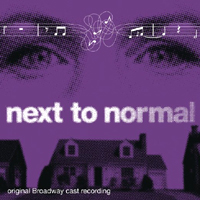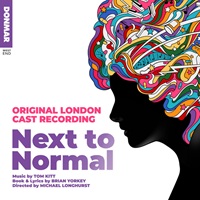 Original Broadway Cast, 2009 (Sh-K-Boom)
Original Broadway Cast, 2009 (Sh-K-Boom)  (5 / 5) If Spring Awakening marked the successful comeback of the original pop/rock musical theater score, then Next to Normal helped insure its future. Part of the reason for the show’s success is that, despite its vibrant energy, it’s a very intimate piece that wears its large heart earnestly on its sleeve. The musical tells of the inner turmoil of a suburban family due to the mental instability of the mother, Diana, who has struggled with bipolar disorder ever since a traumatizing event years earlier: Her son, Gabe, whom she still imagines to be present, died when he was a baby. Although the plot at times borders on being that of a Lifetime Movie, the smart, pulsating score, given a crisp representation on this recording, keeps Next to Normal fresh and inventive. Brian Yorkey’s lyrics are strong and well defined, often bringing a touch of humor to cut the tension in the plot (for example, “My Psychopharmacologist and I”). Tom Kitt composed a score with both fire (“You Don’t Know,” “Didn’t I See This Movie”) and sweet sadness (“I Miss the Mountains”) that he orchestrated excellently with Michael Starobin, making the work electric yet still inherently theatrical. The cast, on the whole, is excellent. Alice Ripley tears into the role of Diana with an abandon that’s fearless, thrilling and at times unnerving. Occasionally, the performer seems so at one with the part that you might fear she won’t even make it to the end of the number — but she always does. J. Robert Spencer is very moving as the silently suffering husband, Dan, and so is Jennifer Damiano as daughter Natalie. Because of the surprises in the plot, listeners who haven’t seen the show will find it especially important to read the synopsis included in the CD booklet in order to make full sense of the story and songs such as “I’m Alive” and “There’s a World,” both sung by Gabe (Aaron Tveit). But they’ll have no problem understanding the emotional potency of each song. — Matt Koplik
(5 / 5) If Spring Awakening marked the successful comeback of the original pop/rock musical theater score, then Next to Normal helped insure its future. Part of the reason for the show’s success is that, despite its vibrant energy, it’s a very intimate piece that wears its large heart earnestly on its sleeve. The musical tells of the inner turmoil of a suburban family due to the mental instability of the mother, Diana, who has struggled with bipolar disorder ever since a traumatizing event years earlier: Her son, Gabe, whom she still imagines to be present, died when he was a baby. Although the plot at times borders on being that of a Lifetime Movie, the smart, pulsating score, given a crisp representation on this recording, keeps Next to Normal fresh and inventive. Brian Yorkey’s lyrics are strong and well defined, often bringing a touch of humor to cut the tension in the plot (for example, “My Psychopharmacologist and I”). Tom Kitt composed a score with both fire (“You Don’t Know,” “Didn’t I See This Movie”) and sweet sadness (“I Miss the Mountains”) that he orchestrated excellently with Michael Starobin, making the work electric yet still inherently theatrical. The cast, on the whole, is excellent. Alice Ripley tears into the role of Diana with an abandon that’s fearless, thrilling and at times unnerving. Occasionally, the performer seems so at one with the part that you might fear she won’t even make it to the end of the number — but she always does. J. Robert Spencer is very moving as the silently suffering husband, Dan, and so is Jennifer Damiano as daughter Natalie. Because of the surprises in the plot, listeners who haven’t seen the show will find it especially important to read the synopsis included in the CD booklet in order to make full sense of the story and songs such as “I’m Alive” and “There’s a World,” both sung by Gabe (Aaron Tveit). But they’ll have no problem understanding the emotional potency of each song. — Matt Koplik
 London Cast, 2025 (Ghostlight Records)
London Cast, 2025 (Ghostlight Records)  (4.5 / 5) Almost 15 years after its Broadway bow, Next to Normal finally came to the West End, in a new production directed with searing intensity by Michael Longhurst. It first played at the Donmar Warehouse, transferred to Wyndham’s Theatre, then received a pro-shot video that aired a year later on PBS. Fans will quickly notice that this “cast recording” is simply the lifted audio of that video, with the audience response muted and, thankfully, Yorkey’s uncensored lyrics retained. As such, the balance of the music and vocals heard here is not as polished as one has come to expect from modern cast recordings, and since we have a primarily British cast, there are one or two faux-American accents that can be jarring. But even with those caveats, this is a thrilling recording. Thanks to singing actors who are vocally exceptional as well as emotionally raw, this Next to Normal pulsates with energy and feeling that practically seeps into your bloodstream. Leading the way is Caissie Levy as Diana. Levy starts out at a more subdued emotional and vocal level than Alice Ripley on the OBC recording, but she quickly builds herself into a manic frenzy, crashing into devastating brokenness, all while maintaining a soaring belt that gives the score a fresh exuberance. She’s equally matched by Jamie Parker’s gregarious Dan (though his American affect is perhaps the most egregious), as evidenced by their explosively combative rendition of “You Don’t Know/I Am the One.” Jack Ofrecio is sweet as the supportive Henry, and Trevor Dion Nicholas brings gravitas to the dual doctor roles. But the ultimate standouts of this recording are Eleanor Worthington Cox as Natalie and Jack Wolfe as Gabe. Cox feels like a weeping, open wound with a pristine singing voice, while Wolfe is more menacing as Gabe than Tveit had been in the original production, and he flies through his songs with a light pop sound that never feels mannered or put on. More balanced audio and some slight accent tweaking would have made this a perfect recording. But, in a way, being “almost perfect” makes Next to Normal even more stirring. — Matt Koplik
(4.5 / 5) Almost 15 years after its Broadway bow, Next to Normal finally came to the West End, in a new production directed with searing intensity by Michael Longhurst. It first played at the Donmar Warehouse, transferred to Wyndham’s Theatre, then received a pro-shot video that aired a year later on PBS. Fans will quickly notice that this “cast recording” is simply the lifted audio of that video, with the audience response muted and, thankfully, Yorkey’s uncensored lyrics retained. As such, the balance of the music and vocals heard here is not as polished as one has come to expect from modern cast recordings, and since we have a primarily British cast, there are one or two faux-American accents that can be jarring. But even with those caveats, this is a thrilling recording. Thanks to singing actors who are vocally exceptional as well as emotionally raw, this Next to Normal pulsates with energy and feeling that practically seeps into your bloodstream. Leading the way is Caissie Levy as Diana. Levy starts out at a more subdued emotional and vocal level than Alice Ripley on the OBC recording, but she quickly builds herself into a manic frenzy, crashing into devastating brokenness, all while maintaining a soaring belt that gives the score a fresh exuberance. She’s equally matched by Jamie Parker’s gregarious Dan (though his American affect is perhaps the most egregious), as evidenced by their explosively combative rendition of “You Don’t Know/I Am the One.” Jack Ofrecio is sweet as the supportive Henry, and Trevor Dion Nicholas brings gravitas to the dual doctor roles. But the ultimate standouts of this recording are Eleanor Worthington Cox as Natalie and Jack Wolfe as Gabe. Cox feels like a weeping, open wound with a pristine singing voice, while Wolfe is more menacing as Gabe than Tveit had been in the original production, and he flies through his songs with a light pop sound that never feels mannered or put on. More balanced audio and some slight accent tweaking would have made this a perfect recording. But, in a way, being “almost perfect” makes Next to Normal even more stirring. — Matt Koplik
